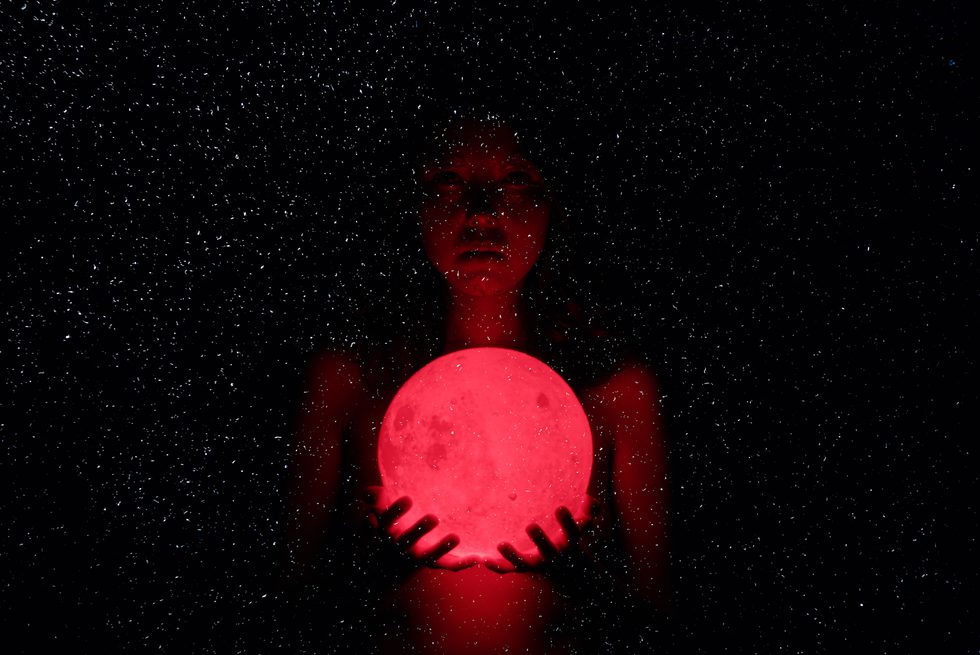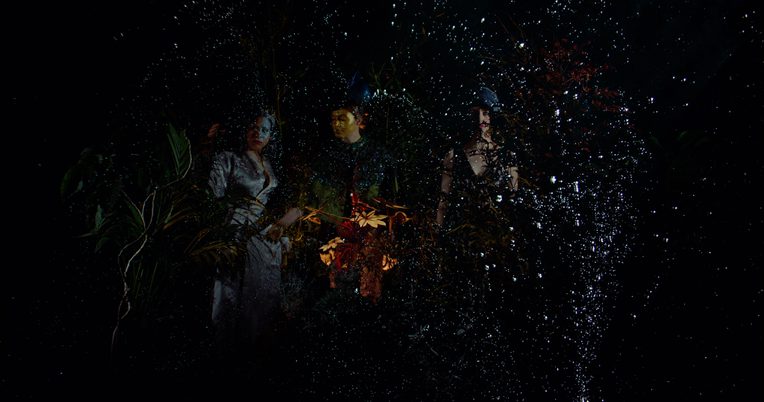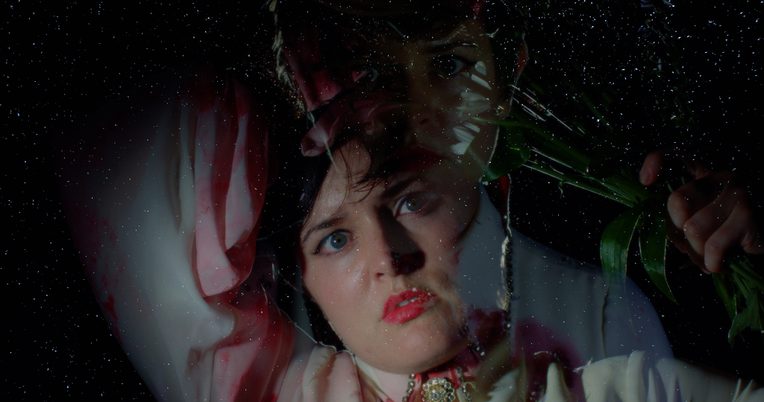
What will I do? What will I do without exile, and a long night that stares at the water? Water binds me to your name . . . Nothing takes me from the butterflies of my dreams to my reality: not dust and not fire . . . We have become two friends of the strange creature in the clouds . . . and we are now loosened from the gravity of identity’s land.
—Mahmoud Darwish, “Who Am I, Without Exile?” (The Butterfly’s Burden, 2007)
On a chilly and overcast day this past July, I met with the director and founder of Dublin’s Experimental Film Society, Rouzbeh Rashidi. For quite some time I had followed his work—and that of the collective’s—on social media, and was pleasantly surprised when I reached out to him for a conversation about the resonances between anthropology and experimental cinema and was received with sincerity and generosity that is not always the case for us anthropologists. Rashidi originally hails from Tehran, Iran, but has resided in Ireland for fifteen years, and in this admittedly short period of time, he has successfully built an enduring and innovative space of support for Ireland’s most daring filmmakers. There is an eerie grittiness to his work that is simultaneously sensuous and off-putting. Watching his films both enraptures and estranges. Ultimately experiments in form, Rashidi’s cinema is disinterested in presenting our worlds as either truth or fiction. Instead, it is stained with ghosts and irrevocably infused with the uncanny. In what follows, I draw parallels between ethnographers and filmmakers with the aid of Rashidi, who himself asserts that the power of experimental cinema lies in the crafting and presentation of “partial truths.” And it is not only that filmmakers and anthropologists are constantly crafting stories from images and texts that bring the two practices together, but the fact that our creations possess the tendency to haunt. This haunting aura—the presence of specters and otherworldly affects—is arguably linked to where anthropology and filmmaking derive their power, that is, through the experience of exile and displacement.
Ghosts of Images, Images of Ghosts: The Materiality of Decay
In her book, What It Is, cartoonist Lynda Barry (2008, 56) asks, “What is the difference between an image and a ghost?” Barry means this as a comparative and generative exercise, I am certain, but it is useful to think with here. Images and ghosts are made, essentially; they are constituted by processes that are meant to create likenesses of others. But what actually makes an image into a ghost or a ghost into an image?
Over coffee at the Library Bar in Dublin’s Temple District, I speak to Rashidi, first, about the origins of his Experimental Film Society, which began in Tehran. This soon turns to his fascination with technology and the process of decay. “I was always a cinephile. This was prohibited because of it being a Western product. And it was always analog technology—VHS. People would show up with suitcases of bootlegged films,” he recounts. A brief pause and Rashidi continues, explaining he was just eighteen years old when he started to make films. Above all, however, he wished to play with the format, deeply intrigued by 35 millimeter technology. “So, what is cinema?” he asks. “Where do images come from?”
Uncertain whether I am meant to answer, I mention Lynda Barry’s quote to him. Rashidi nods fiercely and shifts in his seat, jumping into his obsession with cinematic technology. “It’s the decay,” he points out, which seems to link images and ghosts together. After he became aware of the potential for VHS tapes to be textured, he was entirely captured by the materiality of film. In watching a VHS time and time again, or re-recording over the 35 mm film, he’d witness the colors wash out. “It degrades, but it is still there,” he remarks. “I found myself asking: ‘Why does it become like this?’ It’s like a ghost, basically!” And this is exactly why he came to prefer the 80s and 90s—analog technology—for telling cinematic stories. DVDs, quite simply, do not possess any ghostly or ethereal qualities. Well, at least not naturally.
It is this materiality of decay that Rashidi emphasizes that I wish to meditate on for a brief moment. French historian Marc Bloch (1964) once wrote of historical narratives leaving "tracks" in our world, like little footprints or stains. Michel-Rolph Trouillot (1995) takes this one step further, and rather elegantly so when he describes the production of history as informed by the twinning or confluence of that which has happened (Historicity 1) and that which is said to have happened (Historicity 2). While Trouillot’s critical point is that we must trace the moment that power enters the story by acknowledging the relations between process and narrative, his concept of Historicity 1 highlights the inextricably material ways that history manifests around us; in other words, the materiality of history is what grants the past any power in the first place. Materiality, Trouillot reveals, comes to both represent and embody the "facts of the matter"—as tangible evidence, they may prove difficult to dispute. Yet even landscapes, bodies, fossils, and monuments contain bottomless silences—it is impossible for us to recognize the sedimentation of so many different stories deposited in one object. History, then, is inherently ambiguous and liminal; stories are always being created, destroyed, and recycled.
When Rashidi speaks of the materiality of decay as the mode through which he realizes film, he hones in on the ways in which anthropologists and filmmakers make texts and images that will perpetually experience "afterlives." Perhaps, as anthropologist Stephan Palmié (2002, 2013) has previously argued, all stories are ghost stories. An assemblage of gyrating stories, history as produced by that which has happened and that which is said to have happened resonates with the notion of what once was and what might be, Mark Fisher’s (2012) backbone of haunting. As Fisher contends, haunting occurs not only through spatial and temporal displacement, but through imagined failed futures. Narratives need neither be firmly rooted in the past, present, nor future. Decay, like haunting, indexes the passage of time, but we know little of anything else. What is history, if but a bundle of traces, preserved and animated residues from which we can never escape? If anything, it is an intangible specter constituted by the past lives of tangible things.

Of Mediums and Magicians: A Ghostly Communion?
As we speak of ghosts and the uncanny, Rashidi directs my attention to other parts of the cinematic past that inspire his oeuvre. “How are they made, and why are films the way they are?” he queries. “I like to think of cinema as magic—it is the element of phantasmagoria that makes them leave a mark.” Shadow play, zoetrope, and magic lantern—all early technologies—are what Rashidi cites as methods designed to astonish. “Films should still stun us,” he asserts. And indeed, his approach to film and the art of filmmaking is certainly stunning. “It’s been over twenty years of filmmaking for me, and I’ve made over one hundred films.” He pauses and adds that he feels as if it’s “a bit of an illness,” but I assure him it’s far from it.
“I think most of us are driven by passion,” I suggest.
Rashidi responds by saying it’s not only passion but an obsession. In some ways, that may be the only way we can account for a corpus of work such as his at such a young age (he’s not quite forty). So, too, Rashidi’s cognizance of phantasmagoria’s power endows his films with their otherworldly images and cadence. One of his most recent films, Phantom Islands, is hallucinatory, washed-out, and punctured. While it tells a story of passion between two lovers, the montage of images—along with other editorial decisions on his part—highlights the haunted (and wild) quality of Ireland’s landscape. To achieve these effects, Rashidi intentionally deployed nineteenth-century optics. “This kind of self-imposed austerity,” he explains, “creates the hazy, unfocused or cloudy nature of the film. These are hard and difficult lenses, but I had to find a way to really capture the enigmatic qualities of Ireland. When you live in a place like this, which is characterized by the whole ‘four seasons in one day,’ that constant flux or turbulence, it becomes imperative to capture this . . . Not to mention that there is a part of Ireland that seems to speak to me.”
I nod at his comments. There is something particularly harrowing about Ireland’s landscape, and I’m not afraid to agree. Although I couldn’t call myself Irish today, I am a third-generation Sicilian-Irish-American—my dad’s grandfather left a small parish full of linen factories on what is today the border between the Republic of Ireland and Northern Ireland. A century of disconnection—or, rather, exile—does not make me immune to Rashidi’s observations. Ireland’s landscape feels haunted, even mournful, imprinted with layers of affective attachments that have been suddenly severed by an undulating, uneasy history. This is a country full of ghosts—literally and figuratively—and Rashidi explores this visually whereas anthropologists resurrect these specters through our texts.
“I think of myself as a medium. There is a portal between the universes, and I mediate or transmit energies as I create films. It is because of this that I see my practice as . . . alchemical. Or shamanic, even. Because when you are making film, things happen that are completely out of your control. And the job of the director,” he insists, “is to enter into this chaos. You can control this in editing.”
“Can you say a little more about the shamanic aspects of directing?”
“Of course. It is like I am having a séance when I am trying to trap images,” he states. “The art of filmmaking—any good cinema—captures ghosts or these entities quite well.”
Here Rashidi indeed points to the shamanistic qualities of filmmaking; in so doing, he highlights filmmaking as a ritual act. It is both intentional and transformational; the film director traps images in order to re-arrange them and tap their inherent social and emotive powers. The mediation of subjects and objects is likewise seen in ethnography. Both the filmmaker and the anthropologist are mediums, conjuring ghosts and channeling the voices and absent presence of "others." We immortalize subjects vis-à-vis the creation of objects and products that continue to live on even after the process is over and we have approximated "death."
In a post on Instagram, a platform where Rashidi is very active, he elaborates further. “After the making of a film—shooting, gathering the material, editing/montage—there’s a feeling of loss, nostalgia.” A kind of death occurs, accompanied by grief and mourning. The film is done, effectively dead, yet “[i]t behaves as if it is alive.” In other words, it lives on. “This is why,” he continues, “cinema is all about ghosts and shadows in my view.” There is a palpable similarity in process, then, between the two "arts" if we might call anthropology exactly that. Films and other ethnographic products—whether these are monographs, articles, soundscapes, photos, or other recordings—are "what once was" and "what might be," to again invoke the critic and media theorist Mark Fisher (2012). And even if the author has died, the "copy"—that is, the work we created—continues to exist.
Alienation, Exile, Displacement: The Many Tongues of Estrangement
The potent and palpable "atemporality" of film and of ethnographic enterprises adds to their respective spectral presences. By representing pasts in the present for the future, they also exist in the spaces between. Ethnographers and filmmakers are spatially and temporally out of joint in their quest to "make the strange familiar and the familiar strange." I might even go so far as to say that good ethnography and art are rooted in exile. Any kind of displacement—self-imposed or inflicted—generates the feeling that we are "out-of-joint" which explains the specters, the looming sense that we are haunted.

Rashidi describes himself as experiencing a form of alienation upon his arrival in Ireland in 2004. Yet at the same time, he had felt an alien in Iran given his experimental filmmaking practice. “So, I thought, given the circumstances, why not make a fantasy for myself to survive, producing otherworldly things.” His hard work has paid off, and even despite his estrangement from Iran, he directed a film there over Skype—no small feat. As mentioned from the beginning, Rashidi’s entire oeuvre reflects this sense of alienation and estrangement—a preoccupation with apparitions is nothing more than a certain cognizance of the fact that ghostly presences hinge on (dis)connection. Put another way, relations gone awry, severed, or reconfigured harness the potential of conjuring phantoms. This said, however, alienation and estrangement are sisters to exile; and any discussion of exile brings us to questions of home.
We did not talk of whether or not Rashidi wanted to ever "return"—the concept of return is contentious and highly personal. But he did mention that there is a “liminality to my existence. How to be home when one is always feeling estranged? It’s this question of where is home if you have left one place for another and don’t feel quite at home in either.” Despite the Experimental Film Society’s wild success, he made a point of stressing to me that the Experimental Film Society is currently most celebrated outside of Ireland, especially in places across Latin America and southern Europe. “At times,” he recalls, “the Irish have expressed to me that they find my representations of Ireland—which aren’t really representations, I am filming the landscape—unsettling. They feel disturbed or violated by the images.” There are some exceptions, though. He quickly mentions that the society is accepted by the avant-garde scene in Cork, the western part of the Republic. “This said, I don’t know what we really are. We are neither Irish Underground New Wave, nor Irish New Wave.”
I take a moment with these reflections. Together with "home" and "belonging," Rashidi seems to be describing the ethnographic experience. There is an “us” and “them” when making cinema, not unlike the often fraught positionality of the anthropologist. By making the strange familiar and the familiar strange, artists and anthropologists transcend barriers and transform worlds. But the price of doing so is that we must estrange ourselves—the incidental or self-imposed isolation of the ethnographer is accomplished by exile. And it is exile that produces enormous understanding and awareness. Moreover, it is an encounter with the "otherworld" in some ways, especially as we all look to alternate realities and ontologies.

The Anthropologist and the Artist
The centrality of exile to the ethnographic project, as well as the artistic process, is palpable. Exile is what (re)shapes us into proper ethnographers and is what imbues art with its power to impact us on psychic and emotional levels. What remains is the question of what we do with exile—it is a negatively charged term that bespeaks a sense of loss. Must we lose a part of ourselves when we craft art and ethnography, and what does that mean? To fragment and shatter things in order to pick them up and weave them into a tapestry of meaning or a montage of images invokes once more not only James Clifford’s (1986) notion of "partial truths" or fictions, but also the sense that cinema and ethnography are monstrous. Composed of many moving parts, they take on a life of their own—as Rashidi says—even after we put them to rest. Yet even with this in mind, we cannot escape the ghosts, the present absences or absent presences—the holes or wounds that result from our projects of reconstitution and resurrection. Any act of reassembly is haunted.
In writing this essay, I myself have created a kind of chimera, manifested a ghost. A medium for this story, among others, anthropologists and artists can never escape the feeling that we are haunted, located on the fringes of society. For that matter, it would seem that our early-twentieth-century desires to understand witchcraft would best be understood as an effort to understand ourselves. To see witchcraft on its path, as E. E. Evans-Pritchard once claimed in his classic monograph, is to realize the intrinsic magical qualities of ethnographic practice. Mediums for others, conjurers of texts and images invested in creating and taming chaos, all through a self-imposed estrangement, turns us into sorcerers. As projects and fieldwork end, the symbolic death of the object that Rashidi refers to occurs. Yet our creations persist, encounters transformed. Monographs, articles, and films are constituted by ghosts, continuously resurrected, remembered, and mobilized. Perhaps, we might even go so far as to say they are ghosts.
References
Barry, Lynda. 2008. What It Is. Montreal: Drawn and Quarterly.
Bloch, Marc. 1964. The Historian's Craft: Reflections on the Nature and Uses of Hisotry and the Techniques and Methods of Those Who Write It. New York: Vintage Books.
Clifford, James. 1986. "Introduction: Partial Truths." In Writing Culture: The Poetics and Politics of Ethnography, edited by James Clifford and George E. Marcus, 1–26. Berkeley: University of California Press.
Darwish, Mahmoud. 2007. The Butterfly's Burden. Translated by Fady Joudah. Port Townsend, Wash.: Copper Canyon Press.
Evans-Pritchard, E. E. 1976. Witchcraft, Oracles, and Magic among the Azande. Oxford: Oxford University Press.
Fisher, Mark. 2012. "What is Hauntology?" Film Quarterly 66, no. 1: 16–24.
Palmié, Stephan. 2002. Wizards and Scientists: Explorations in Afro-Cuban Modernity and Tradition. Durham, N.C.: Duke University Press.
———. 2013. "Historicist Knowledge and Its Conditions of Impossibility." In The Social Life of Spirits, edited by Ruy Blanes and Diana Espírito Santo, 218–40. Chicago: University of Chicago Press.
Trouillot, Michel-Rolph. 1995. Silencing the Past: Power and the Production of History. Boston: Beacon Press.